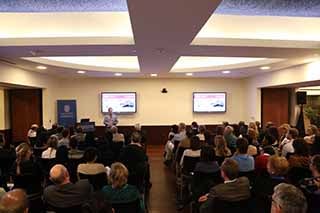Georgetown University Qatar Presents the History of Jerusalem’s Changing Demographics

The Center for Regional Studies (CIRS) at Education City’s Georgetown University Qatar (GU-Q) hosted recently Micha Kurz at their Monthly Dialogue Series public lecture, where he delivered a lecture titled “Mobilizing Communities in Occupied Jerusalem”.
Kurz, a former IDF soldier who is the co founder of Grassroots Jerusalem, an online platform that connects urban and human rights activists and organizations in Jerusalem, discussed the current demographic situation of this ancient city in terms of recent political events stemming from the creation of Israel. He then detailed the socio economic impact on Palestinian communities in light of the ongoing struggle to establish a majority benchmark of Jewish citizens. “When we discuss Jerusalem or Palestine, we don’t often use terms like employment, dropout rates, or what the Occupation really means. So I want to focus on that so we can understand what we are talking about,” he said.
Detailing the various government policies that have shifted over the decades in response to persistent failure in meeting these demographic goals, Kurz demonstrated how the strategy of instituting checkpoints, then building a wall, have effectively cut off the old inner city, and economic center, from the suburbs, where displaced Jerusalemite Palestinians had been relocated. Combined with Israeli law that punishes Jerusalem’s Palestinian citizens by revoking their residency permit if they are gone for more than 3 years, the impact on Palestinians has been massive, he explained. “Students can’t go to school, consumers can’t do business, and over 5,000 Palestinian businesses have shut down. Unemployment is at its peak – a 75% poverty rate in East Jerusalem alone.”
He described the events of World War II that led to the emergence of a Jewish state and set off a demographic race. “The first priority of the Israeli government was for Israeli neighborhoods to grow as much and as fast as possible, with new neighborhoods built very quickly, mostly on Palestinian farmland,” said Kurz, who was born and raised in Jerusalem, and recounted childhood memories of counting the building cranes on the city’s horizon.
The partition of Jerusalem into East and West following the 1949 War, the first time in the city’s long history of peaceful coexistence between Christians,Jews, and Muslims, resulted in a major displacement of Palestinians from Jerusalem. From a population of 850,000, only 50,000 remained following the partition. “The other government priority was that Palestinian neighborhoods were to be frozen. No Palestinian growth or new neighborhoods since 1967. You won’t find that in a black and white lawbook, but you’ll find a demographic benchmark on a government website, that says Jerusalem is to maintain a 79% Jewish majority of the city.”
Kurz concluded that it is imperative the central business district be opened back up to the Palestinian people, saying “This all has to do with politics. While everyone discusses the two state solution, peace, dialogue, and coexistence, what we should be talking about is human rights and justice.”
Dr.Mehran Kamrava, Director of CIRS, introduced Kurz to the audience of students, faculty, and members of the Doha community by saying “I met Kurz while I was doing research in Jerusalem for a course I’m teaching this semester. Within five minutes of speaking to him, I knew that I had to find a way to bring him to one of our Monthly Dialogue lectures. I was thrilled and delighted he agreed to come.” Next month’s lecture, which is open to the public, will present CIRS director of research, Zahra Babar, who will discuss Arab communities in Qatar.